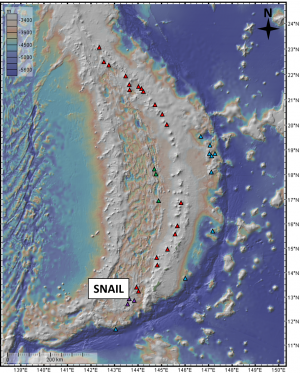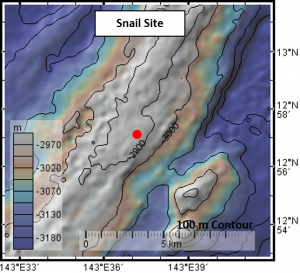
Snail Vent


Latitude: 12.95320οN Longitude: 143.61900οE Depth: 2860 m bsl
Alternative names: South back-arc spreading center, Fryer site (Kato et a., 2010)
The Snail site is located on the axis of the spreading ridge (Kakegawa et al., 2008) in Mariana Trough. It is an active hydrothermal system with white-gray smokers (Kato et a., 2010) and some dead chimneys (Yoshikawa et al., 2012). The maximum temperature of fluids measured is about 270°C and the fluids are rich in H2S (Kato et a., 2010). The biodiversity includes several bacterial species, barnacles, shrimp and snails (Kato et al., 2010; Kato et al., 2012; Kumagai et al., 2015).
Table 1: Operations history for Snail vent
| Ship/ Platform | Operation | Year | Dive Number | References |
| Hakurei-Maru #2 cruise | BMS (Benthic Multi-coring System) | 2004 January | Not found | YK05-09-Leg2 cruise report |
| RR1413 R/V Roger Revelle/ Jason | XBT, CTD | 2014 | J2-797 | Submarine Ring of Fire 2014-Ironman |
| TN-153 R/V T. G. Thompson | EM 300 multibeam; CTD tow-yo | 2003 February – March | Not found | Submarine Ring of Fire 2003 |
| YK05-09 Yokosuka/ Shinkai 6500 | WHATS, ROCS, Bag with high temperature probe, pH, pCO2, ORO sensors | 2005 July-August | 902, 904 | YK05-09-Leg2 cruise report |
| YK10-10 Yokosuka/ Shinkai 6500 | Not found | 2010 August | 1215, 1218 | YK10-10 cruise report |
| YK10-11 Yokosuka/ Shinkai 6500 | Not found | 2010 September | 1220, 1227, 1228 | YK10-11 cruise report |
Table 2: Vent activity and host rocks
| Activity and host rocks | References | |
| Activity | Active | Kato et al., 2010 |
| Host Rocks | Basalt | Toki et al., 2015 |
Table 3: Vent fluid characteristics
| Vent Fluids | References | |
| Temperature (οC) | 45-248
278 |
Toki et al., 2015; Kakegawa et al., 2008, Ikehata et al., 2015 |
| pH | 3.52 | Toki et al., 2015 |
| Composition | Moderately high H2S concentrations | Kato et a., 2010 |
| CO2 (mM) | 78.8 | Toki et al., 2015 |
| H2 (μM) | 549 | Toki et al., 2015 |
| Mn (mM) | 2.08 | Toki et al., 2015 |
| Fe (mM) | 0.64 | Toki et al., 2015 |
| CH4 (μM) | 29.6 | Toki et al., 2015 |
Table 4: Vent Biology
| General name | Phylum | Class/Order | Family | Genus/Species | References |
| Bacteria | Aquificae | Aquificales | Hydrogenothermaceae | Persephonella | Kato et al., 2012 |
| Bacteria | Proteobacteria | Gammaproteobacteria | Thiomicrospira | Kato et al., 2012 | |
| Bacteria | Proteobacteria | Gammaproteobacteria | Methylomonas | Kato et al., 2012 | |
| Bacteria | Proteobacteria | Gammaproteobacteria | Methylobacter | Kato et al., 2012 | |
| Bacteria | Proteobacteria | Epsilonproteobacteria | Campylobacterales | Hydrogenimonas | Kato et al., 2010; Kato et al., 2012 |
| Bacteria | Proteobacteria | Epsilonproteobacteria | Campylobacterales | Sulfurimonas | Kato et al., 2010; Kato et al., 2012 |
| Bacteroidetes | Toki et al., 2015 | ||||
| Bacteria | Proteobacteria | Zetaproteobacteria | Mariprofundus | Kato et al., 2012 | |
| Barnacle | Arthropoda | Multicrustacea | Neoverrucidae | Neoverruca brachylepadoformis | Kumagai et al., 2015 |
| Shrimp | Arthropoda | Malacostraca | Alvinocarididae | Chorocaris vandoverae | Kumagai et al., 2015 |
| Snail | Mollusca | Gastropoda | Provannidae | Alviniconcha hessleri | Kumagai et al., 2015 |
Images:
- Snails, crabs, shrimp, and anemonies compete for space at Snail Vent hydrothermal site
Video Links:
- Footage from the dives at Snail Vent and Urashima (note: search “Footage from the dives at Snail Vent and Urashima”).
References:
- Ikehata, K., Suzuki, R., Shimada, K., Ishibashi, J., Urabe, T., 2015. Mineralogical and Geochemical Characteristics of Hydrothermal Minerals Collected from Hydrothermal Vent Fields in the Southern Mariana Spreading Center. In: Ishibashi, J., Okino, K., Sunamura, M. (Eds.), Subseafloor Biosphere Linked to Hydrothermal Systems: TAIGA Concept. Springer Japan, 275-287.
- Kakegawa, T., Utsumi, M., and Marumo, K., 2008, Geochemistry of Sulfide Chimneys and Basement Pillow Lavas at the Southern Mariana Trough (12.55°N-12.58°N): Resource Geology 58 (3), 249-266.
- Kumagai, H., Watanabe, H., Yahagi, T., Kojima, S., Nakai, S., Toyoda, S., Ishibashi, J., 2015. Evaluating Hydrothermal System Evolution Using Geochronological Dating and Biological Diversity Analyses. In: Ishibashi, J., Okino, K., Sunamura, M. (Eds.), Subseafloor Biosphere Linked to Hydrothermal Systems: TAIGA Concept. Springer Japan, 49-59.
- Toki, T., Ishibashi, J., Noguchi, T., Tawata, M., Tsunogai, U., Yamanaka, T., and Nakamura, K., 2015, Chemical and Isotopic Compositions of Hydrothermal Fluids at Snail, Archaean, Pika, and Urashima Sites in the Southern Mariana Trough. In: Ishibashi, J., Okino, K., Sunamura, M. (Eds.), Subseafloor Biosphere Linked to Hydrothermal Systems: TAIGA Concept. Springer Japan, 587-602.
- Yoshikawa, S., Okino, K., and Asada, M., 2012. Geomorphological variations at hydrothermal sites in the southern Mariana Trough: Relationship between hydrothermal activity and topographic characteristics. Marine Geology 303-306, 172-182.
Website References:
- Submarine Ring of Fire 2003 http://oceanexplorer.noaa.gov/explorations/03fire/logs/summary/summary.html (accessed 11/26/2015)
- Submarine Ring of Fire 2014- Ironman http://oceanexplorer.noaa.gov/explorations/14fire/logs/photolog/photolog.html (accessed 11/26/2015)
Cruise Reports:
- Yokosuka cruise report YK05-09-Leg2 http://www.godac.jamstec.go.jp/catalog/data/doc_catalog/media/YK05-09_leg2_all.pdf (accessed 11/26/2015)
- Yokosuka Cruise Report YK10-10 http://www.godac.jamstec.go.jp/catalog/data/doc_catalog/media/YK10-10_all.pdf (accessed 11/26/2015)
- Yokosuka Cruise Report YK10-11 http://www.godac.jamstec.go.jp/catalog/data/doc_catalog/media/YK10-11_all.pdf (accessed 2/22/2017).

